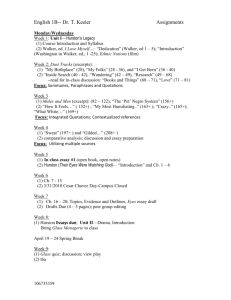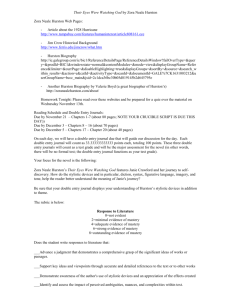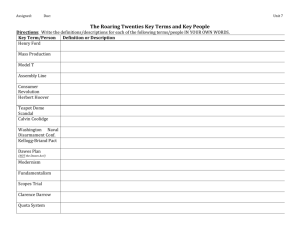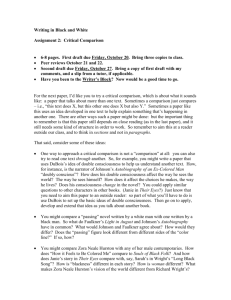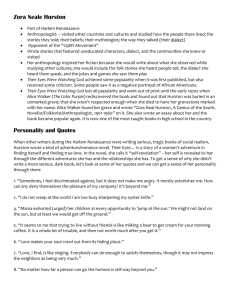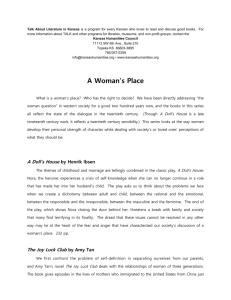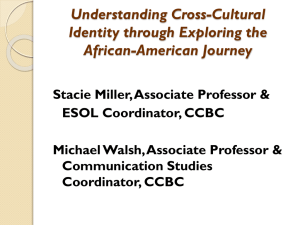1. Introduction to African-American Studies: Booker T. Washington
advertisement
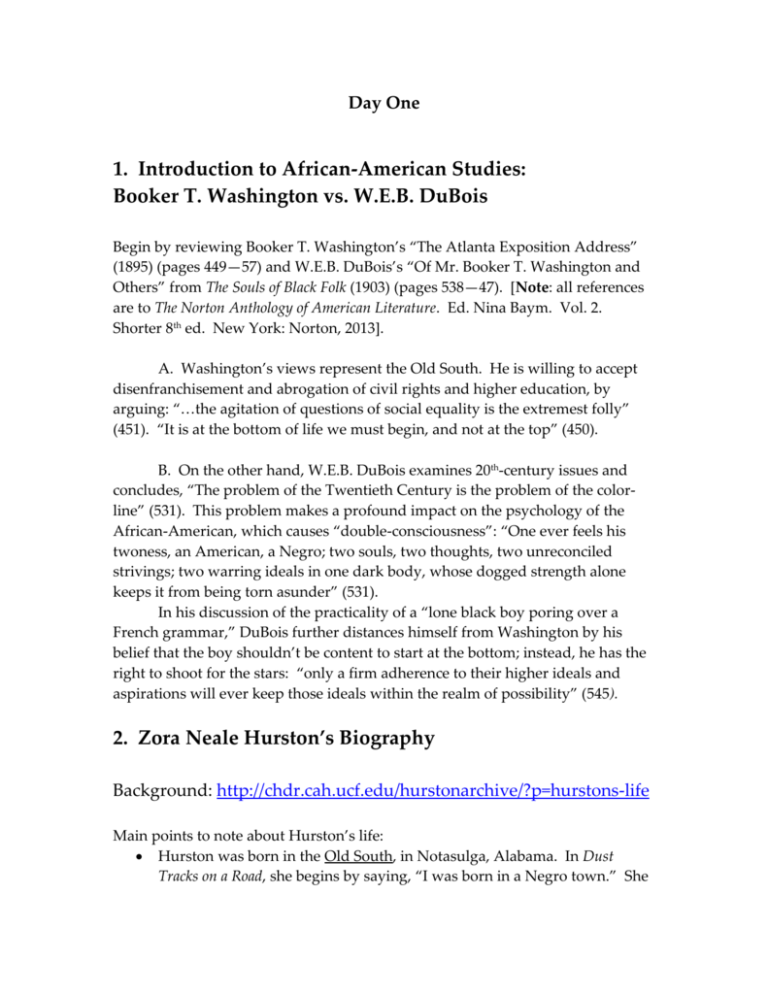
Day One 1. Introduction to African-American Studies: Booker T. Washington vs. W.E.B. DuBois Begin by reviewing Booker T. Washington’s “The Atlanta Exposition Address” (1895) (pages 449—57) and W.E.B. DuBois’s “Of Mr. Booker T. Washington and Others” from The Souls of Black Folk (1903) (pages 538—47). [Note: all references are to The Norton Anthology of American Literature. Ed. Nina Baym. Vol. 2. Shorter 8th ed. New York: Norton, 2013]. A. Washington’s views represent the Old South. He is willing to accept disenfranchisement and abrogation of civil rights and higher education, by arguing: “…the agitation of questions of social equality is the extremest folly” (451). “It is at the bottom of life we must begin, and not at the top” (450). B. On the other hand, W.E.B. DuBois examines 20th-century issues and concludes, “The problem of the Twentieth Century is the problem of the colorline” (531). This problem makes a profound impact on the psychology of the African-American, which causes “double-consciousness”: “One ever feels his twoness, an American, a Negro; two souls, two thoughts, two unreconciled strivings; two warring ideals in one dark body, whose dogged strength alone keeps it from being torn asunder” (531). In his discussion of the practicality of a “lone black boy poring over a French grammar,” DuBois further distances himself from Washington by his belief that the boy shouldn’t be content to start at the bottom; instead, he has the right to shoot for the stars: “only a firm adherence to their higher ideals and aspirations will ever keep those ideals within the realm of possibility” (545). 2. Zora Neale Hurston’s Biography Background: http://chdr.cah.ucf.edu/hurstonarchive/?p=hurstons-life Main points to note about Hurston’s life: Hurston was born in the Old South, in Notasulga, Alabama. In Dust Tracks on a Road, she begins by saying, “I was born in a Negro town.” She disavows her true birthplace for the following reasons: to distance herself from the days of slavery and the fact that her father was born a slave and to associate herself with the mythology of the creation of an all-black town in the New South of Eatonville, Florida. Hurston changed the date of her birth from 1891 to 1901, 1903, and 1910. She might have wanted to appear more modern by claiming that she was born in the 20th century. Or, practically speaking, she may have lied about her age in order to enter high school when she was living in Baltimore. Booker T. Washington helped establish the Hungerford Academy in Eatonville, where Hurston went to elementary school. He sent his teachers there to establish vocational training to go along with more academic studies. It is rumored that he was engaged to Hurston’s sister. Hurston had a fairly idyllic childhood until her mother died when she was 14. Her father quickly married a young woman, a few years older than Hurston and with whom Hurston fought. She was turned out of her home and sent to live with her siblings. She was never to have a true home again for the rest of her life or feel the unconditional love of another person for any substantial length of time. Hurston was the first black graduate of Barnard College. While she was in New York, she became an integral member of the Harlem Renaissance. Hurston always dreamed of being a playwright, probably more than being a novelist. She was always looking for a way to break into the theater world. Hurston had a warm, supportive friendship with the Florida novelist Marjorie Kinnan Rawlings, who wrote about the small community of Cross Creek. Hurston’s Seraph on the Suwanee is dedicated to Rawlings. Black male writers critiqued Hurston’s Their Eyes Were Watching God for its lack of political correctness. They felt that she should deal with social and racial issues in her work. Hurston did not believe that race should be considered in the estimation of a person’s character. Her experience growing up as a valued member of an all-black community built her innate racial self-esteem. In all of her work, Hurston portrays many African-American communities (in the Everglades, Harlem, Polk County, etc.) beyond the monolithic Eatonville. Hurston earned less than $1,000 in royalties during her lifetime. Poverty plagued her later years. At the end of her life, Hurston was obsessed with the story of Herod the Great. She felt that he was the patriarchal, multi-cultural founder of Western civilization. Listen to Hurston’s voice at Florida Memory. She recorded these tapes of black folk songs when she worked for the WPA in 1935 and in 1939. These tapes are located in the Library of Congress: http://www.floridamemory.com/audio/hurston.php Another interesting tape on YouTube records Hurston’s lecture on zombies. In scientific detail, she explains the existence of zombies http://www.youtube.com/watch?v=YmKPjh5RX6c 3. Eatonville, Florida Read about Eatonville at http://chdr.cah.ucf.edu/hurstonarchive/?p=communities Hurston writes in her memoir, Dust Tracks on a Road: “I was born in a Negro town. I do not mean by that the black back-side of an average town. Eatonville, Florida, is, and was at the time of my birth, a pure Negro town— charter, mayor, council, town marshal and all” (3). In fact, Hurston was born in Notasulga, Alabama, and arrived in Eatonville when she was one or two years old. Her father, a former slave, left the Old South of Alabama to seek work in the all-black, New South community of Eatonville, Florida. Hurston wanted to create her own image of herself as a child of the first incorporated AfricanAmerican community. Eatonville was established by twenty-seven African American males on 18 August 1887. Her father, John Cornelius Hurston, was the minister of one of the two churches in town and served as mayor from 1912 to 1916 Map of Eatonville (Mapquest Eatonville, Florida) Photo Tour of Eatonville Eatonville, Florida is located in Orlando near Maitland and Winter Park. The main street is Kennedy Boulevard, which runs through the town. Very few of the buildings from Hurston’s era still exist. The Hurston family home, Joe Clark’s store, and Hungerford Academy are all gone. The Moseley House, home of Hurston’s best friend in town—Matilda Clark Moseley, a niece of Joe Clark— has been restored. Hurston’s memorial Kennedy Boulevard Location of the Hurston family home Current location of Joe Clark’s store St. Lawrence Church Thomas House Moseley House—sign Moseley House 4. Two of Zora Neale Hurston’s Themes A. Individual Empowerment Zora Neale Hurston portrays the traditional black woman and her struggle to achieve self-actualization in Their Eyes Were Watching God. The traditional black woman, born under slavery, is represented by Nanny, who calls the black woman “the mule of the world.” Nanny has higher aspirations for her grand-daughter than what was available for her: “Ah wanted to preach a great sermon about colored women sittin’ on high, but they wasn’t no pulpit for me” (15). When Nanny speaks of “sittin’ on high,” she means from a position of material wealth and social standing. Deborah Plant in her book, Every Tub Must Sit on Its Own Bottom, claims that Hurston’s view of female empowerment has nothing to do with this type of hierarchical posiiton, from “sitting on high,” but comes from erasing gender lines: As an ardent individualist, Hurston practiced a politics of self that defied stereotypical conventions of sex and sex roles. In her personal life, she was able to embrace both masculine and feminine principles in a way that empowered her to achieve what she did. Hurston is not an anomaly, but part of a continuum of “manly women” that can be traced from the United States and other parts of the African Diaspora to the African continent itself. We can also look to Zora Neale Hurston as a model of empowerment. (6-7) An interesting topic to discuss is Hurston’s own struggle to maintain her independence. In the chapter entitled “Love” in Dust Tracks on a Road, Hurston describes her love affair with Percy Punter, who pressured her to give up her career, marry him, and become a traditional wife. She had to break the affair off in order to retain her individuality. In her essay, “How It Feels to Be Colored Me,” Hurston celebrates this individuality. B. Erasure of Racial Lines Hurston’s attitude toward slavery appears to be one of denial. Her father had been born a slave in Notasulga, Alabama, but she wants to move beyond this inheritance: “I turn my back on the past. I see no reason to keep my eyes fixed on the dark years of slavery and Reconstruction” (Dust Tracks 331). In reality, she strongly felt that people should be judged on their own merits, with no regard to skin color. She writes in Dust Tracks on a Road: “Negroes are just like anybody else” (329). Her view was based, first, on her own experiences in all-black Eatonville where she saw blacks running the town with no help from whites. Second, her anthropological studies with Dr. Franz Boas at Barnard College taught her that the concept of race is a social construct and does not explain the differences that exist between people. Boas believes that it is the environment that shapes individuals and their groups. Viewed as a "friend of the Negro," Boas was a scholar whose theories of racial equality helped to "uplift the race," according to Lee Baker (40). Boas was so well regarded in the outside world that he appeared on the cover of the May 1936 issue of Time magazine. The cover article refers to Boas's most famous study, The Mind of Primitive Man, as "the Magna Charta of self respect for the `lower races'" and goes on to note: "Boas observed that nowhere on earth was there such a thing as a pure race, and that the term `race' was vague and approximate at best"; furthermore, Boas doubts that there are any "superior races" (qtd. in Baker 42). Anyone who believes in the inferiority or superiority of races is full of “Nordic Nonsense,” in Boas's opinion (42). Two years later, on 10 December 1938, Boas led 1,284 scientists from 167 universities in signing a “Scientists’ Manifesto” denouncing Nazi theories of race. The goal of the manifesto was “to counteract the vicious, pseudo scientific activity of so-called scientists who try to prove the close relation between racial descent and mental character” (43). Although Boas’s anti-Nazi activity was still in the future at the time Hurston was his student in the 1920s, he had formulated his views about race during this earlier period. Boas's views on race also affected the Harlem Renaissance. Susan Hegeman claims that his views, which claimed that “African Americans were fully capable of becoming valued members of American society irrespective of their race,” was instrumental in creating a “type of thinking" that was “important to the development of the Harlem Renaissance," namely, that “black Americans possessed a particular cultural heritage, identity, and destiny” (473). Unfortunately, Hurston’s views on race were not universally appreciated. Her male critics particularly denigrated her attitude towards race in her fiction, because they felt she didn’t deal with the social and political complexities—and brutalities—of race. Houston Baker in Modernism and the Harlem Renaissance believes that Hurston’s concept of slavery is based on her “naivete.” Richard Wright objects to her “minstrel” characters. Arna Bontemps claims that she “deals very simply with the more serious aspects of Negro life in America—she ignores them.” Ralph Ellison says that Their Eyes Were Watching God “retains the blight of calculated burlesque that has marred” her work. He faults the novel for being “the story of a Southern Negro woman’s love-life against the background of an all-Negro town into which the casual brutalities of the South seldom intrude.” In contrast, writers today praise Hurston’s forward-thinking perspective on race. Alice Walker says: [Hurston] was exposing in [Their Eyes Were Watching God] not simply an adequate culture, but a superior one . . . That they could be racially or culturally inferior to whites never seems to have crossed her mind. . . . the quality I feel most characteristic of Zora’s work: racial health—a sense of black people as complete, complex, undiminished human beings, a sense that is lacking in so much black writing and literature. (Bloom 63) She also had a confidence in herself as an individual that few people (anyone?), black or white, understood. This was because Zora grew up in a community of black people who had enormous respect for themselves and for their ability to govern themselves. Her own father had written the Eatonville town laws. This community affirmed her right to exist, and loved her as an extension of itself. For how many other black Americans is this true? It certainly isn’t true for any that I know. In her easy selfacceptance, Zora was more like an uncolonized African than she was like her contemporary American blacks, most of whom believed, at least during their formative years that their blackness was something wrong with them. . . . There is not book more important to me than [Their Eyes Were Watching God]. Works Cited Baker, Lee. Baker, Lee D. “Franz Boas Out of the Ivory Tower.” Anthropological Theory 4 (2004): 29-51. Bloom, Harold. Zora Neale Hurston. New York: Chelsea House, 2003. Hegeman, Susan. “Franz Boas and Professional Anthropology: On Mapping the Borders of the ‘Modern.’” Victorian Studies 41 (1998): 455-84. Hurston, Zora Neale. Dust Tracks on a Road. Urbana: U Illinois P, 1984. Plant, Deborah G. Every Tub Must Sit on Its Own Bottom. Urbana, IL: University of Illinois Press, 1995. Walker, Alice, editor. “I Love Myself When I Am Laughing…” New York: Feminist Press, 1979. 5. Discussion Questions 1. What obstacles did Hurston face in her lifetime and how did she overcome them? What elements of self-empowerment did she experience? 2. What effect did Florida have on Hurston’s life and work? What is the image of Florida that appears in her stories? 3. Why would Hurston claim that she was born in an “all-black town” and change the date of her birth? Is she undermining her ability to tell the “truth”? 4. Compare Hurston’s themes to those of a white male author, such as Mark Twain. How do their worldviews play out in their novels?
